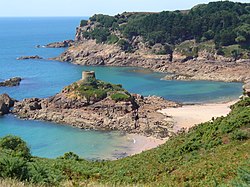Saint Brélade, Jersey
| Saint Brélade | ||
|---|---|---|
| Jersey parish | ||

St. Brelade's coastline of promontories and bays includes Portelet and its tidal island, L'Île au Guerdain with Portelet Tower (also known as Janvrin's Tomb)
|
||
|
||
 Location of Saint Brélade in Jersey |
||
| Crown Dependency | Jersey, Channel Islands | |
| Government | ||
| • Connétable | Steve Pallett | |
| Area | ||
| • Total | 12.8 km2 (4.9 sq mi) | |
| Area rank | Ranked 2nd | |
| Population (2011) | ||
| • Total | 10,568 | |
| • Density | 830/km2 (2,100/sq mi) | |
| Time zone | GMT | |
| • Summer (DST) | UTC+01 (UTC) | |
| Postcode district | JE3 | |
| Postcode sector | 8 | |
| Website | www |
|
Saint Brélade is one of the twelve parishes of Jersey. Its population is around 9,560, and it occupies the southwestern part of the island. It is the only parish to border only one other parish, St. Peter. The parish is the second-largest parish by surface area, covering 7,103 vergées (3,157 acres or 12.78 km²), which is 11% of the total land surface of the island.
Its name is derived from a 6th century Celtic or Welsh "wandering saint" named Branwalator or Saint Brelade (also Branwallder, Broladre, Brelodre, Brélade), who is said to have been the son of the Cornish king, Kenen. He is also said to have been a disciple of Samson of Dol, and worked with this churchman in Cornwall and the Channel Islands.
St Brelade's Church is situated at the end of St. Brélade's Bay, an unusual situation being comparatively distant from historic centres of population. The small Fisherman's Chapel alongside contains mediaeval frescoes which survived the iconoclasm of the Reformation. According to folklore, the reason for the siting of the parish church is that originally the St. Bréladais intended to build the church inland, much nearer to the homes of the congregation. However les p'tits faîtchieaux (the little people) who had their temple in a nearby dolmen were disturbed by the construction of the foundations and, every night, would undo the construction work and magically transport all the tools and materials down to the shoreline. Eventually the humans gave up and built the church where the fairies had indicated.
...
Wikipedia

